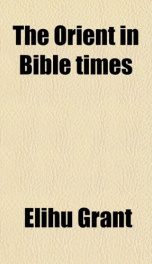the orient in bible times

Purchase of this book includes free trial access to www.million-books.com where you can read more than a million books for free. This is an OCR edition with typos. Excerpt from book: CHAPTER IV Egypt and Palestine.The survey up to this point gives one the general background for the Ancient World around the eastern end of the Mediterranean. But from this time on actual information concerning Palestine is more often obtainable. This change is made possible very largely through the discovery, a generation ago, of a large number of letters written from Palestine in the period of Amenhotep HI and IV. With the first of those reigns began the participation of Egypt in the famous correspondence known to us from the Tell el-Amarna letters. The name given to the collection is taken from the ruined site in Egypt where they were found by peasants. They contain the diplomatic notes and state correspondence of governors and kings in Asia who wrote to the Egyptian pharaohs. They were written on clay tablets in the Babylonian language and the cuneiform character. They testify to the dominant position established by Thothmes in Asia. They give just as clear evidence of the cultural influence of the Babylonians in the age immediately preceding the Egyptian sway. The most intimate knowledge of ancient oriental politics is afforded by the documents. International and provincial complications, ambitions and motives are revealed with life-like faithfulness. Most of the letter-writers were local rulers of Syria and Palestine more or less submissive to the court of Egypt, but a small number is from foreign potentates. Burnaburiash, the Kassite king of Babylon, and Dushratta of Mitanni land are repre- sented. In the letters from the provinces one can mark the decline of Egyptian prestige from the reign of Amenhotep III to that of his son, the fourth of the name. The Amarna letters make archaeologists curious to know what became of the corresponding letters from Egypt to foreign...
Info about the book
Author:
Series:
Unknown
ISBN:
0965981428
Rating:
2.5/5 (3)Your rating:
0/5
Languge:
English
Users who have this book
Users who want this book
What readers are saying
What do you think? Write your own comment on this book!
write a commentif you like the orient in bible times try:
Other books by this author
Do you want to exchange books? It’s EASY!
Get registered and find other users who want to give their favourite books to good hands!


